In the rich tapestry of Indian culture, West Bengal stands as a vibrant hub of tradition and artistic expression. One of the most exquisite elements contributing to this cultural grandeur is the traditional attire- the saree. West Bengal sarees, known for their intricate weaving techniques, vibrant colours, and cultural significance, have earned a special place in the hearts of connoisseurs and fashion enthusiasts alike.
Bengal's Timeless Craftsmanship: At the heart of West Bengal's saree legacy lies the art of weaving, a tradition that has been passed down through generations. The state is renowned for producing some of the finest sarees in the country, each bearing the imprint of skilled craftsmanship and cultural heritage.
Here are some of the prominent sarees from Bengal-
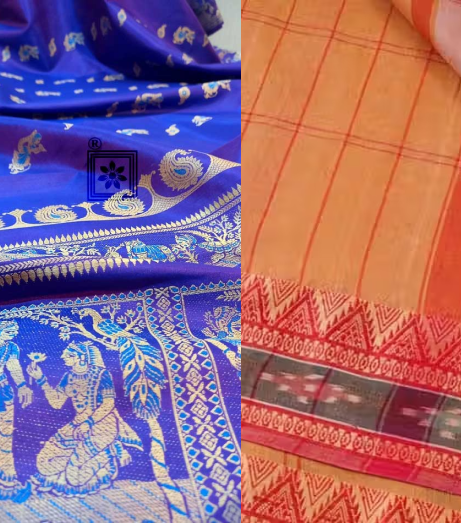
Baluchari Sarees:
- Origin: Baluchari sarees trace their roots to the town of Baluchar in Murshidabad.
- Weaving Technique: These sarees are known for their intricate depictions of mythological scenes from the Ramayana and Mahabharata woven into the fabric.
- Material: Baluchari sarees are usually crafted from fine silk, giving them a lustrous appearance.
Dhaniakhali Sarees:
- Origin: : Dhaniakhali sarees hail from the Dhaniakhali region of West Bengal.
- Weaving Technique: These sarees are characterised by simplicity and elegance, featuring fine cotton texture with minimalistic designs.
- Usage: Dhaniakhali sarees are suitable for both casual and formal occasions due to their lightweight and comfortable nature.
Tant Sarees:
- Origin: Tant sarees, also known as Bengal cotton sarees, are widely produced in West Bengal.
- Weaving Technique: Traditional handloom technique, creating a fine texture.
- Material: Tant sarees come in a variety of colours and are often adorned with simple patterns, making them popular for daily wear.
Murshidabad Silk Sarees
- Origin: Murshidabad, a historical city in West Bengal, is known for its silk sarees.
- Weaving Technique: Murshidabad silk sarees are characterised by their use of pure silk and intricate zari work, often depicting traditional motifs.
- Occasions: These sarees are favoured for weddings and festive occasions due to their opulent appearance.
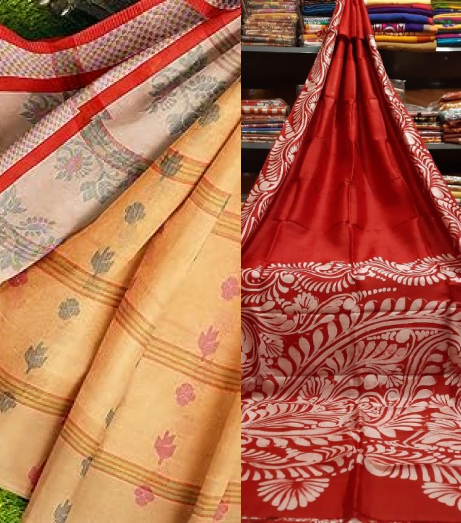

Tussar:
- Origin: Derived from the silk of wild silk-producing caterpillars, Tussar sarees boast a natural sheen and a distinctive texture.
- Usage:The earthy tones and intricate handcrafted designs make Tussar sarees a symbol of Bengal's rich weaving heritage and artistic tradition.
Garad and Korial Sarees:
- Designs: Garad and Korial sarees are known for their distinct red borders and plain white or off-white body.
- Usage: Garad sarees are traditionally worn during Durga Puja and other religious ceremonies, while Korial sarees are preferred for weddings.
Jamdani Sarees
- Weaving Technique: Jamdani sarees are woven using a supplementary weft technique, creating intricate and artistic designs.
- Patterns: These sarees often feature floral and geometric patterns, showcasing the craftsmanship of the weavers.
Khadi Sarees
- Material Khadi sarees are crafted from hand-spun and handwoven khadi fabric.
- Weaving Technique: The use of khadi fabric adds a rustic and traditional appeal to these sarees.
Muslin Sarees
- Material Muslin sarees are made from fine and delicately woven muslin fabric.
- Weaving Technique: Known for their sheer texture and lightweight feel, muslin sarees showcase the finesse of Bengal's weaving tradition.
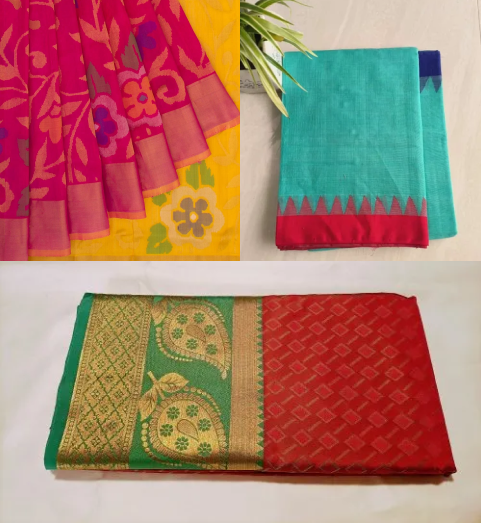

Colours that Speak Volumes: West Bengal sarees are a riot of colours, reflecting the cultural diversity and vibrancy of the state. The colour palette ranges from bold reds and vibrant yellows to serene whites and subtle pastels. Each colour holds cultural significance, with red symbolising marital bliss, white representing purity, and yellow signifying auspiciousness. The play of colours in West Bengal sarees adds a distinctive charm, making them a visual feast for the beholder.
The Drape of Tradition: The way a saree is draped is as crucial as its design. In West Bengal, the saree is typically draped in the traditional Bengali style, known as the "Athpourey" or "Seedha Pallu" drape. This style involves pleating the pallu at the back and bringing it over the left shoulder, creating an elegant and sophisticated look. The traditional drape complements the intricate designs of the saree, adding an extra layer of grace to the wearer.
Preserving Heritage in Modern Times: While rooted in tradition, West Bengal sarees have also evolved to meet the demands of contemporary fashion. Designers are incorporating modern elements without compromising the authenticity of the craft. The fusion of traditional motifs with contemporary designs has given rise to a new wave of West Bengal sarees that appeal to both the traditionalist and the fashion-forward.
West Bengal sarees are more than just pieces of fabric; they are a living testament to the rich cultural heritage of the region. The artistry, craftsmanship, and vibrant colours embedded in each weave tell a story that transcends generations. Whether donned for a festive celebration, a wedding, or a casual gathering, West Bengal sarees continue to be the epitome of timeless elegance, celebrating the spirit of Bengal in every fold.
Some popular saree outlets in Kolkata-
Adi Mohini Mohan Kanjilal, College Street
Specialises in pure handloom sarees and provides authentic silk mark
Priya Gopal Bishoyi, Gariahat
Very attractive silk sarees: Silk in Baluchari, silk in Murshidabadi or Bishnupuri style, and also Tussar silk with Madhubani paintings.
Adi Dhakeswari Bastralaya, Gariahat and Rasbehari
For both silk and cotton sarees
Basak, Gariahat
One of the oldest saree shops in Kolkata, Basak has forever showcased the heritage of Bengal tant in their products. Basak is known for selling authentic handloom Jamdani sarees.
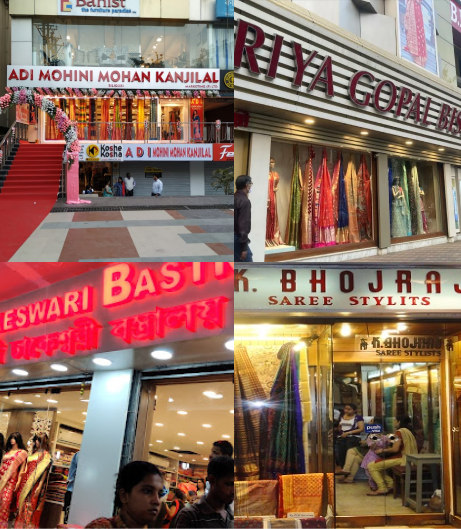
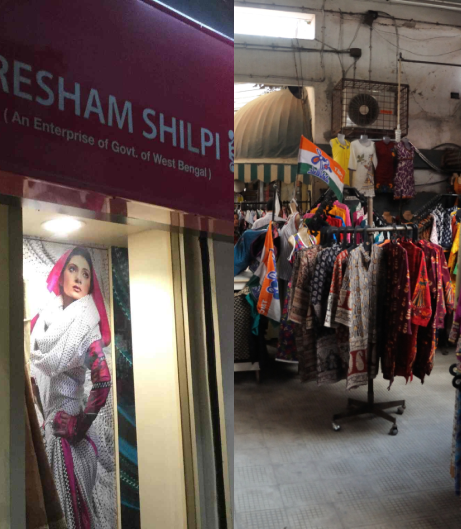
Resham Shilpi
Paschim Banga Resham Shilpi Samabaya Mahasangha Limited (PBRSSML) is a Federation of Primary Khadi Cooperative Societies formed for the promotion and sale of silk items being produced by the Primary Weavers’ Cooperative Societies. PBRSSML procures silk, matka, tussar fabric (kora thaan) from Primary Cooperative Societies. The fabric is then printed by enlisted printers. Self-Help groups are also engaged for embroidery on tussar, dyed silk. Garad and Baluchari sarees are also procured from the cooperative societies.
Dakshinapan
Spread over 57,000 sqft area and has 141 shops, it is shopping complex, the latter consisting mainly of outlets specialising in various types of handlooms, handicrafts, textiles, furniture, fancy goods and imitation jewellery. It also houses State emporiums from all over India.
For a more contemporary fare, enthusiasts are encouraged to visit ByLoom and Bhumisuta both at Hindustan Park.

